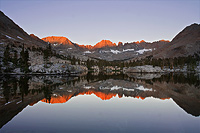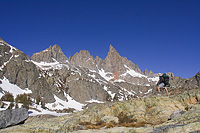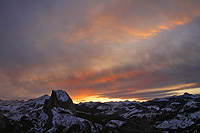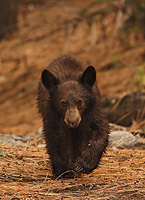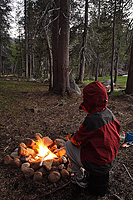Home -> Articles -> Nature Photography and Backpacking
Photography and Backpacking
written by Greg Cope
Introduction: At the age of 18 I was introduced to backpacking with a trip into the Trinity Alps of California. Dreaming of this experience since I was a child, it was eye opening for me - even as I kneeled outside my tent on the first night out throwing up from some bad cheese my brother brought along - I marveled in the connection I made with the wilderness around me. Since that experience years ago, I have explored countless corners of nature backpacking, and the scenes I saw while backpacking was one of the major driving forces behind me taking up nature photography.
In thinking about why the combination of backpacking and photography is so special to me, there are the obvious reasons that come to mind. From a nature photographers perspective, backpacking has allowed me to photograph remote locations in amazing light. Waking up next to a glassy lake reflecting the jagged peaks aglow in the morning light beyond; standing near a flower filled meadow just as a thunderstorm clears and the sun sets; sitting beside a lake watching the moon light up the peaks as the stars streak across the sky. These are all a nature photographers dream come true. And they are all magical experiences that are easily found while backpacking. But there also seems to be a more elusive, deep routed reason why I found the combination of backpacking and photography so appealing.
Traveling into Sequoia National Park to an area known as Kaweah Basin earlier this year, I felt I found that deep routed reason. Every basin, canyon, and pass I hiked through, every creek I crossed, every animal I encountered had a unique feeling and appeal to it that I could never describe in words. The magic of a basin seen by few people in the world, the feeling of exhaustion and accomplishment standing on top of a 12,000ft pass, the fright of being several feet from a bear staring me right in the eye - this was what nature photography was about, trying to capture that magic and those feelings in a photograph. A fantastic blend of art and nature.
This is not to say that trying to photograph a popular roadside location is any less special - many of my favorite photographs were taken beside the road - some even looking out the window of my car. But spending days out in nature - be it alone or with others - tends to bring into my mind new (and old) thoughts and feelings that are then translated into my photography - where I notice subtle things, combinations, and patterns - where I ultimately learn not only something about my photography, but something about myself.
Backpacking Gear: If you've never backpacked*, it shouldn't be looked upon as a daunting undertaking. Sure, starting from scratch gives the impression you need a lot of gear you may know nothing about, but the gear and information is all readily available. There are countless books and websites to help you learn, and many places where you can see lists of what others carry. You also have the option to rent gear from stores such as REI. Of course the best way to start is to tag along with someone who has experience, where you can borrow gear and gain experience. But also simply hiking in a few miles from the trailhead to camp with no experience can be quite rewarding and relatively safe, although I don't necessarily condone it. The rules and regulations of the area you camp should be heeded either way - permits, human waste disposal, camping restrictions, and etiquette.
The gear you choose to carry should be based upon where you plan on going and in what season you plan on backpacking in - the weather, temperatures, etc...There is a huge difference between summer and winter camping, desert or alpine camping. In general you will need a tent, sleeping bag, sleeping mat, camping stove with fuel, pot, clothes, food and food storage method, maps, compass, first aid kit, pocket knife, sunscreen, insect repellant, light, lighter or matches, water purification method, and backpack (in my opinion backpacks should be chosen as one of the final items, after it is know what weight and volume you will be carrying). Each one of these items is a topic in and of itself - the styles, brands, weights, functionalities - so short of going into depth on each, suffice it to say that there are many choices for each item. It is always best to research the particular brands available, and good websites such as Backpack Gear Test are valuable resources to learn about specific items of gear. Finally, weight is a huge issue when you are carrying all you need on your back. For lighter alternatives to each of these pieces of gear, please see my article on lightweight backpacking.
Photography Gear: To top off your backpack is your photo gear, and carrying a lot photography gear is always a tough thought to come to terms with. In many cases, the camera gear alone can more than double the weight of your backpack. Of course the weight of your photography gear comes down to what camera equipment you ordinarily use and decide to bring along, and what items you can sacrifice. I currently carry at least two Canon 35mm camera bodies, one digital and one film. To complement these I also bring along 3 lenses: a 17-40mm f4.0L for landscapes, a 50mm f1.8, and a 70-200mm f4.0L as well as a 1.4x extender to be used with my telephoto lens to get that much closer to wildlife. I stop short of bringing heavier telephoto lenses. To lighten things up at times I have compromised my 'L' series canon lenses for a lighter non 'L' replacement, as well as carried only a single camera body or left a few of my lenses at home. Normally I leave my telephoto lens on my main camera body for those 'just in case' wildlife situations where both quickness and timing are essential. To finish off this list is my tripod. Rather than opting for my heavy metal bogen tripod, I carry a lightweight tripod. I do not use the center column extensively, and have considered cutting off much of it to save weight. In addition, I occasionally bring along a small amount of lightweight cord and a stuff sack, which I sometimes fill with rocks and hang from the center of my tripod to stabilize it. For several years I carried a small ultrapod and also used bags of rice as lighter substitutes for a tripod, but have found an extending full sized tripod much more reasonable and worth the weight.
Having much of my gear stowed away in my pack has compelled me to avoid taking some pictures simply out of exhaustion, not wanting to remove my pack time and again. I have found two ways to try and rectify this problem. First, I have carried a small point and shoot camera for those shots that don't require a fancy camera setup - many of my photos I take while hiking consist of this type of shot. I can strap this to my shoulder strap or hip belt for very easy access. Alternatively, I have a camera bag which I can harness across my chest that carries much of my gear. With my gear freely available on my chest, I can remove my camera at any time while hiking. While I sewed this camera bag from scratch to custom fit my camera gear and body, any type of reasonably sized camera bag can be used similarly with a few simple modifications. When I first carried my gear this way I was hesitant about the weight of the bag on my chest restricting my breathing. After logging many miles with this bag in different seasons and weather, I have been impressed at how well it functions and how comfortable it is.
Care: Care of your gear is an extremely important measure that must be taken into consideration when backpacking. I always carry my lenses, filters, and camera bodies in a padded case (which I sometimes harness on my chest for easy access while other times will stow away in my pack for safer keeping). Ziploc bags are a marvel when it comes to keeping items dry, and I always carry several extra to pack my camera gear and extras in if rain seems imminent. An umbrella can come in handy to keep your gear dry in even a light rain. At night, my camera and lenses goes as close to being outside as possible - usually in my tent vestibule - I have encountered large temperature and moisture differences between the inside and outside of the tent which can contribute to condensation on my lenses and camera when I take them outside in the morning (especially in winter).
Of course one of the most important things to care for is the nature you encounter. There is nothing worse then setting up camp to find trash scattered periodically around camp. This beauty must be preserved, and there are many things to consider in its preservation. Soap should be avoided, and if you must it should be disposed of far from water sources. Vegetation can be very sensitive and should be treaded on softly or not at all. Human waste should be buried 6" deep far from water sources. All trash, yours as well as trash you may find, should be carried out of the wilderness. Finally, low impact ethics should always be practiced to prevent as much human impact as possible.
Greg Cope
(*Note:I won't go so far and say that backpacking is easy. Climbing up a steep and rough trail carrying a heavy backpack at 12,000ft. is enough to steal the breath of even the most fit, but staying in shape can make it much easier. Exercises like running, weight lifting, and biking all work on cardiovascular and muscular fitness. All your backpacking plans should take into account your fitness, the elevation, and the terrain - because over ambitious plans can result in not only an unpleasant time, but can also put you at risk. If you plan to backpack at high altitudes, acclimate at lower elevations first and pay close attention to any severely abnormal physical symptoms including painful headaches, nausea, and marked fatigue as altitude sickness and high altitude pulmonary edema (HAPE) can be life threatening if not treated soon enough.)
Online Resources
REI: Online store for outdoor and backpacking gear.
Backpack Gear Test: Valuable resource for researching gear.
Backpacker Magazine: Online and Print magazine about backpacking.
Terraserver: Online resource for topographic maps and Satellite Imagery.
Backpacking.net: Online resource for backpacking gear and methods
Summitpost: Online resource for climbers, hikers, and backpackers.
